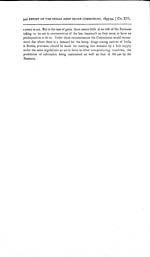Medicine - Drugs > Report of the Indian Hemp Drugs Commission, 1894-1895 > Volume I
(378) Page [343]
Download files
Individual page:
Thumbnail gallery: Grid view | List view
![(378) Page [343] -](https://deriv.nls.uk/dcn17/7443/74435091.17.jpg)
CHAPTER XVII.
SYSTEMS OF NATIVE STATES.
Systems in Native States.
696. The foregoing
chapter contains the views of the Commission on the
introduction throughout
British India of a system
of excise in regard to hemp drugs which will be
ultimately uniform. But this uniformity of system must necessarily
fail of
its purpose unless the co-operation of the Native States which are
interlaced
with British territory is at the same time secured. A brief review
of the
systems at present in force in Native States is therefore
necessary, together with
some remarks as to the desirability of securing the adoption of a
similar system
in those States. The material at the disposal of the Commission in
regard to
the States is somewhat incomplete and fragmentary, but a good deal
of inform-
ation of a general character has been obtained which will enable
the Commission
to come to some decision on the subject.
States in the Himalayan
tract
where the plant grows wild.
697. The conditions under
which the wild hemp is found have been detailed
in Chapter III. Generally it
may be said that the
wild growth only thrives in the Himalayan tract.
The Native States falling within this tract are Kashmir, some of
the Punjab
Hill States, Garhwal Tehri and Rampur in the North-Western
Provinces, Nepal,
Kuch Behar, and the Assam Hill States. In all these States bhang is
produced;
but as the control of bhang in similarly situated tracts in British
territory has
been pronounced impracticable, this fact need not interfere with
British excise
arrangements. Kashmir apparently produces no charas properly so
called, and
all the charas which comes to the Punjab through Kashmir is
accounted for under
the Punjab system of registration. A little charas comes from
Garhwal and from
Nepal, but the amount is not sufficient to disturb British
arrangements. The
cultivation of ganja is prohibited in Kuch Behar, which receives
its supplies from
Rajshahi, the duty being credited to the State. Ganja to a very
small extent is
said to be imported from Nepal, and there is considerable smuggling
of inferior
ganja from the Assam Hill States which has been noticed in Chapter
XV. With
this last exception, it may be stated generally that the system or
want of system
in regard to hemp drugs in all these States is a factor which need
not be taken
into account in the excise system of British India. And as regards
the Assam
Hill States, it is probable that no further preventive measures can
be taken at
present than those already adopted, viz., prevention through
the Assam Excise
establishment when the drug is brought into British territory for
sale. There is
no system in force in the Hill States, and for some time to come it
is not likely
that any can be expected.
In other States the
production of
ganja is the most important feature.
698. The extent to which
the hemp drugs are produced in the Native States
in other parts of India, and
exported from them to
the various British provinces, has been detailed in
Chapters IV and VII of this Report, so far as can be gathered from
the informa-
tion received. It is mainly in respect of the production of ganja
that the arrange-
ments in these States have any perceptible effect on the British
excise system.
The conditions of the principal States or groups of States in this
respect
will be briefly noticed in the following paragraphs as well as the
systems in
force.
Set display mode to: Large image | Zoom image | Transcription
Images and transcriptions on this page, including medium image downloads, may be used under the Creative Commons Attribution 4.0 International Licence unless otherwise stated. ![]()
| India Papers > Medicine - Drugs > Report of the Indian Hemp Drugs Commission, 1894-1895 > Volume I > (378) Page [343] |
|---|
| Permanent URL | https://digital.nls.uk/74574822 |
|---|---|
| Description | Chapter XVII |
| Description | [Volume 1]: Report. |
|---|---|
| Attribution and copyright: |
|




